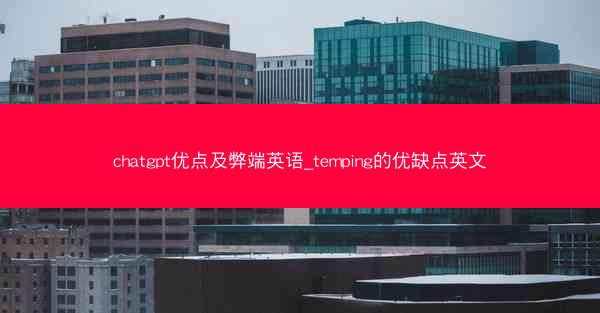
Introduction: The Digital Duos of Dialogue
In the vast digital landscape, two prominent figures stand out in the realm of artificial intelligence: ChatGPT and Temping. These digital entities, while serving different purposes, share a common goal of facilitating human-computer interaction. This article delves into the intriguing advantages and drawbacks of both, unraveling the tapestry of their digital personas.
ChatGPT: The Conversational Colossus
ChatGPT, a brainchild of OpenAI, has revolutionized the way we perceive AI. This language model, powered by deep learning, boasts an array of remarkable advantages.
1. Conversational Prowess:
ChatGPT's ability to engage in natural, fluid conversations is unparalleled. It can understand and respond to complex queries, making it an invaluable asset for customer service and personal assistance.
2. Versatility:
The model's versatility is its cornerstone. Whether it's crafting poetry, writing code, or providing legal advice, ChatGPT's adaptability knows no bounds.
3. Continuous Learning:
With its neural network architecture, ChatGPT continuously learns from its interactions, improving its responses over time. This makes it a dynamic and evolving tool.
However, like any technological marvel, ChatGPT is not without its flaws.
1. Lack of Contextual Understanding:
Despite its conversational prowess, ChatGPT often struggles with understanding the nuances of human language, leading to contextually inappropriate responses.
2. Ethical Concerns:
The potential for misuse, such as spreading misinformation or manipulating conversations, raises ethical questions about the responsible deployment of such technology.
Temping: The Temporary Talent
On the other side of the digital divide, Temping, a platform that connects employers with temporary workers, offers a unique set of benefits and challenges.
1. Flexibility:
Temping provides unparalleled flexibility for both employers and employees. Employers can fill short-term gaps in their workforce, while employees can explore various job opportunities without long-term commitments.
2. Cost-Effectiveness:
For businesses, hiring temporary workers can be more cost-effective than hiring permanent staff, especially for projects with uncertain durations.
3. Skill Diversification:
Temping allows companies to tap into a diverse pool of skills, ensuring that they have the right talent for specific projects.
Despite these advantages, Temping also comes with its own set of drawbacks.
1. Employee Turnover:
The transient nature of temporary work can lead to high employee turnover, which can be detrimental to team cohesion and productivity.
2. Quality Control:
The quality of work can vary significantly among temporary workers, making it challenging for employers to maintain consistent standards.
3. Legal and Compliance Issues:
Navigating the legal and compliance landscape of temporary employment can be complex, especially for companies unfamiliar with the intricacies of labor laws.
Conclusion: The Digital Dilemma
In the digital age, the rise of AI and temporary employment platforms like ChatGPT and Temping has brought about a new set of challenges and opportunities. While these technologies offer unparalleled benefits, they also come with their own set of drawbacks. As we navigate this digital landscape, it is crucial to strike a balance between leveraging these tools to their fullest potential and addressing their limitations to ensure a harmonious and productive future.


